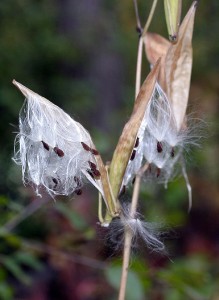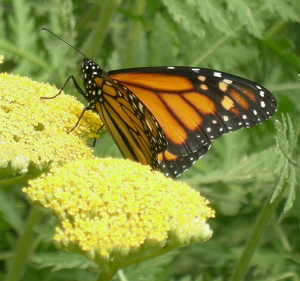
by Great Lakes Now Contributor, Margaret Hetherman
Homo Sapiens may be rapidly gaining a reputation as the most invasive species on the planet, but there are some among us who stand eager to stretch a hand across the divide—to provide safe passage with what has become a virtual railroad for monarch butterflies making a sojourn in escape of the wintry air.
Recognized by their orange and black coloring, the “king of butterflies” can trek up to 3,000 miles in search of a warmer climate, migrating en masse from Canada and the U.S. to Mexico and the sunny groves of California. And like the humans with whom they share the continent, they too require sustenance and pit stops during long runs of travel. Spotlight on: common milkweed.
Not only is the herbaceous plant the preferred stomping ground for reproductive dalliances (for the butterfly, that is), the milky sap is an important food source for the resultant monarch larvae. Furthermore, the plant turns into something both difficult to pronounce and poisonous when ingested: cardenolide aglycones. If the monarch’s bright colors should fail to send predators away, the literally heart-stopping properties of the cardenolides should do the trick. There’s just one problem:
 The milkweed supply has been dwindling.
The milkweed supply has been dwindling.
This is bad news for our fragile-winged friends who face other threats as well. Changes in climate have affected the monarch’s mating patterns and extreme heat is lethal for eggs that have yet to hatch. Add to that, droughts that reduce their water supply and you have a recipe for a threatened species.
Enter Gayle Turner of Ann Arbor, a retired physical therapist with a penchant for lush gardens. Like a parent unable to single out her favorite children, she must be coaxed to name a handful of plants among the 100-plus that grace her yard. When the snow isn’t covering the ground, one easily spots a small curious sign amid the ironweed, spiderworts, lavender, and sage. It reads: “Monarch Waystation.” Butterflies will find a treasure trove of milkweed only several yards away.
Turner earned the official waystation designation through Monarch Watch, a nonprofit program dedicated to preserving monarch migration. As of January 5, 2015, Monarch Watch boasted 9,637 habitats registered on its international database.
Though a plant enthusiast, Turner didn’t set out to intentionally create the habitat. She came to the calling incidentally—the previous homeowner had been careful to save native plants at the time of the house’s construction. He salvaged the milkweed, planted it, and watched it multiply. An important step we should all take during development, Turner notes.
As a member of the Ann Arbor chapter of the “Wild Ones” organization, she shares the passion for preserving natural habitats and landscapes. Over time, her awareness of milkweed has grown along with the buzz surrounding the monarch’s plight. Milkweed has become a big topic of discussion, according to Turner.
“It’s important to put back what’s been taken out,” she states, ever mindful to maintain a cap on quantity lest the milkweed get out of control. “Every plant is important, but even a good plant can be invasive.”
While thousands of individuals like Turner have joined in cultivating pathways of preservation across the country, big-name non-profits are on the case too. National Wildlife Federation is working to provide safe passage for wildlife, making room over bridges and underpasses, to name a few strategies from their playbook. Current initiatives range from restoring roaming spots for bison in Montana, to creating crossings for moose in the Green Mountains of Vermont.
NWF’s Online Campaign Strategy Manager Jennifer Janssen, who is based in the Great Lakes Regional Center, speaks of learning how to live with wildlife, making the animals part of the communities in which we live.
“Wildlife needs to be able to move between areas of really good habitat,” Janssen states. “If we’re living with wildlife, we have to think about what we’re putting out there that is really harming them.” She promotes “protecting their habitat and connecting people to nature . . . and getting kids and families outdoors so they’ll grow up to be the conservationists of the future.”
NWF’s website offers tips on how to “Create a Certified Wildlife Habitat,” from providing food and water, to creating cover and giving wildlife a place to raise their young. Check out their website for more information.
And in March 2015, the organization will launch a new program to distribute milkweed seed to people who want to provide habitats for monarchs—a chance to become a “Butterfly Hero.” The details promise to be as inviting as red clover to the Danaus plexippus (a.k.a. monarch).
The timing couldn’t be better. In early January 2015, the U.S. Fish and Wildlife Service began a yearlong review to determine whether the monarch butterfly should receive federal protection as an endangered, or threatened, species. The monarch population has declined by 90 percent over the past twenty years, in large part due to an agricultural practice here in the Midwest: the use of herbicides to kill milkweed that can grow between rows of crops. In conjunction, soy and corn plants are genetically modified to withstand the toxic chemicals that are showered upon them.
The concept of corridor is more important now than ever, Turner adds, because we are facing development and the loss of habitat everywhere. “Now every time I see grass under power lines, I think, ‘Wow! That’s a corridor’ . . . or along old railroad tracks . . .”
The possibilities are as endless as the reach of nature, when given the opportunity to flourish. But dire times call for a little extra help. There are many ways to get involved, unpaving the way, one person and one monarch at a time.
Learn how to set up a monarch waystation at: http://www.monarchwatch.org/waystations/registry.
3 Comments
-
Wow. Great to know about the concept of corridors and way stations. Very interesting article!
-
Both enjoyable to read and quite informative. Kudos!
-
I heard a story about this topic on NPR, but they didn’t include information on how to get seeds.
I’ll share this info with my friends! Thanks for the great article! 🙂





